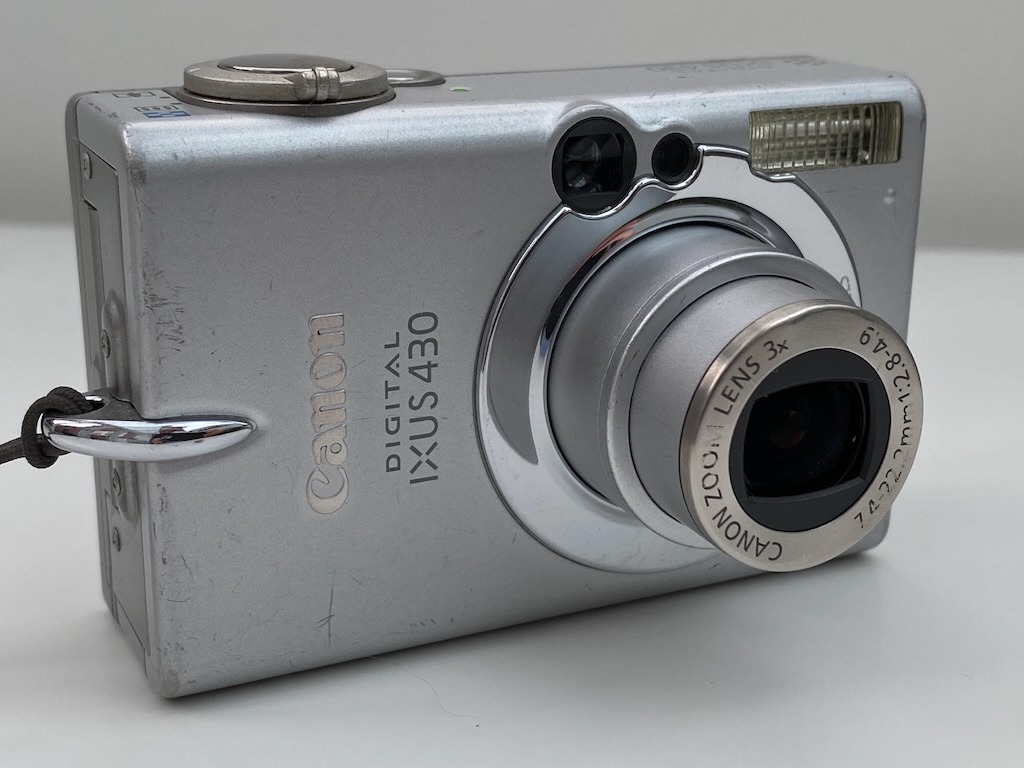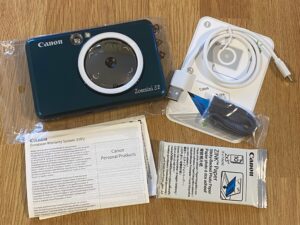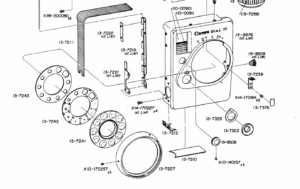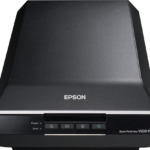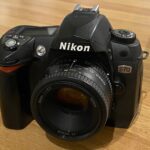The Canon Digital Ixus 400 (Ixy 400 in Japan and Powershot S400 in America) was an utterly iconic digital compact camera, released in March of 2003 into an intensely competitive marketplace. Digital compacts were all the rage in the very early 2000’s and had truly come of age. They came with enough resolution to produce high quality prints, were small enough to slip into a pocket and be carried anywhere and everywhere and memory cards were available to enable hundreds of shots to be stored in a seemingly impossibly small physical space.
The Ixus 400 was the latest in a long line of Ixus bodies that went back to the compact dream of APS film. The original Ixus film cameras were compact marvels that were probably the most compelling holiday cameras ever made at the time, with only the cost of film and developing holding consumers back from snapping away at almost everything they saw.
A few prior Canon compacts had borrowed from the “compact metal box” philosophy – most notably the then recent Powershot S10 and S20 cameras (recently reviewed here) which had crammed really rather spectacular performance into a tiny body. Their drawbacks were resolution and absolutely awful battery life – but they were definitely “not bad” for 1999. A lot had changed in just three years, however. Now Lithium battery technology enabled smaller, longer lasting batteries which meant in turn that camera bodies could be smaller still – Canon now had a way to reproduce the impossibly small yet capable cameras of the early Ixus line, but in digital form.
Yes, there had been a couple of Ixus digitals before these, but they were not much to write home about. The Ixus 400 and it’s later sibling the Ixus 500 were at the pinnacle of compact camera design and performance. With high resolution 4 and 5 megapixel sensors, a decent lens with 3x optical (none of that digital nonsense) zoom, movie mode and stitch assist, these were truly joyful cameras to use and own.
Getting one today, however, is not simple…
In this review:
- Early failures and recall
- Finding a working copy…
- Designing a classic
- Using the Ixus 400 today
- Conclusions and learning
Early failures and recall

In the early 2000’s it was Sony who ruled the compact digital camera market – not necessarily from camera sales, but due to the fact they were the largest manufacturer of compact sensors. Sony sold their sensors to nearly every popular manufacturer of compact cameras at the time – including the grandest of them all, Leica.
In 2004 a batch of Sony sensors were distributed that had suffered some form of manufacturing defect which caused sensors to degrade, exhibiting green and purple casts before producing black images and refusing to work again. The exact cause of the problem was never revealed, although speculation from “inside sources” suggested that the method used to bond tiny wires to the sensor itself had degraded due to incorrect settings on the machinery used to make them. This seems quite plausible – but so does another suggestion that the sensor package had changed to use an epoxy which had started degrading, unlike the usual ceramic packaging that was usual at the time. Either way – the symptoms definitely match with connections gradually, and then totally, failing. There’s an excellent article about it all here.
This caused quite the headache. In 2005 an inevitable recall followed and one by one manufacturers started to publish voluntary repair schemes inviting customers to send their cameras in for repair. It is likely that they just replaced the whole camera at the time as the necessary labour to disassemble the camera, replace the sensor and then calibrate it would’ve cost more than just taking the hit on a whole camera before pursuing Sony for compensation. Whether anyone did take action against Sony is not obvious, but I’d be surprised if large businesses didn’t vigorously pursue their losses in this way.
The thing is, whilst almost all Ixus 400 and 500 cameras received these sensors, they didn’t all fail at once. Indeed, many of them continued to work perfectly for their whole working life. By the time they started to fail, they’d already been consigned to the drawer of old tech and forgotten about – and they had missed the 2007 deadline for free repair. Over time, these sensors have now nearly universally failed leaving people rather disappointed when they dig their old faithful out during a tidy up to discover that it’s given up the ghost.
The only remaining, working Ixus 400 and 500 cameras now are the few that were sent in for repair and those that were lucky enough to avoid the faulty batch, although if there were any of these produced with decent sensors, they’re not exactly plentiful on the second hand market.
Finding a working copy…
You’d think, then, that going after an Ixus 400 or 500 today is quite pointless – and you’d be right. Do a quick search on eBay and you’ll find plenty of them. That’s not unexpected as they sold millions of them, but predictably nearly every single auction is “for parts or not working.” If you do find a cheaper one that appears in good condition, the seller inevitably fails to show the display working or showing the live preview. I can’t think why…

Then you’ve got those which are listed in the chancers “collectible” price bracket, people who are trying to scam some poor soul out of close to £100 on the off chance it might actually work. I wouldn’t touch one of these at anything over a few quid if there wasn’t absolute proof that it’d been through the repair program and received a new sensor. Indeed, the only one I could find that was proven working came from Spain and cost pretty much £100 all in, including postage. Not exactly cheap for something that is essentially a time bomb for your money.
How did I end up with a working one? The answer to that is “completely by accident.” I’d bought some time ago a job lot of “untested” ixus 400’s, I think 6 in all, in the hope that at least one would be working or would stay working long enough to get some images out of it. I managed to bodge one together that worked for a bit but then the sensor failed during use, producing purple lines down the sides until it eventually died completely. I put them in a box in the garage for spares and moved on until recently when I rummaged through them again to discover by some kind of miracle that one of them still worked…
Designing a classic
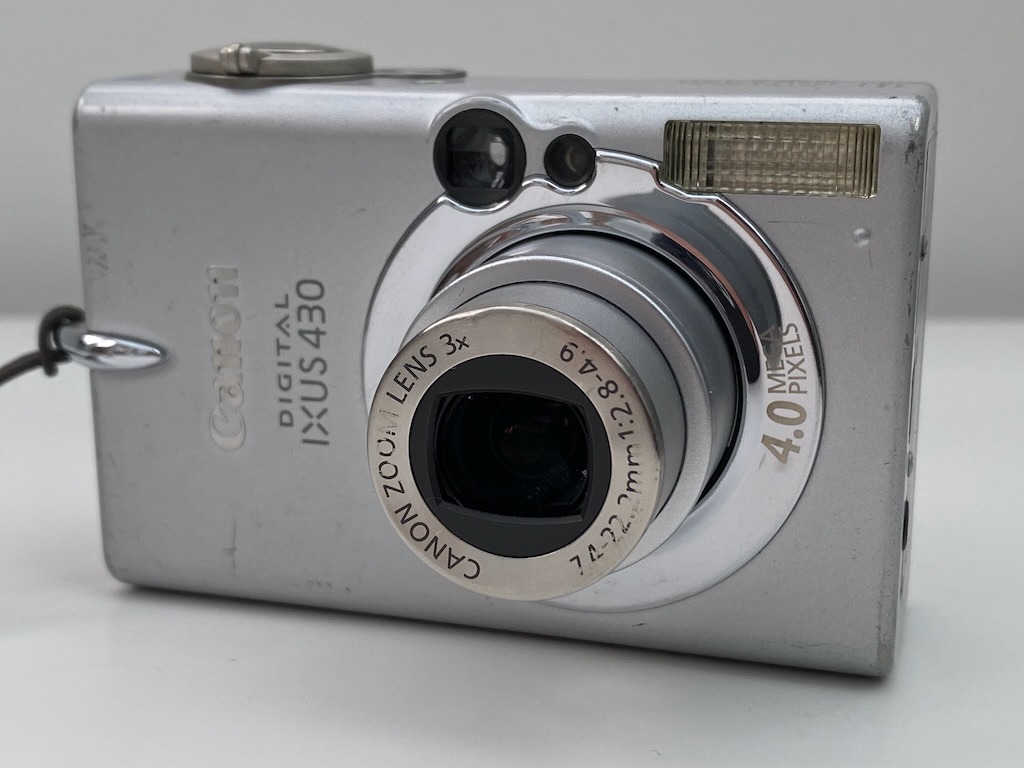 | 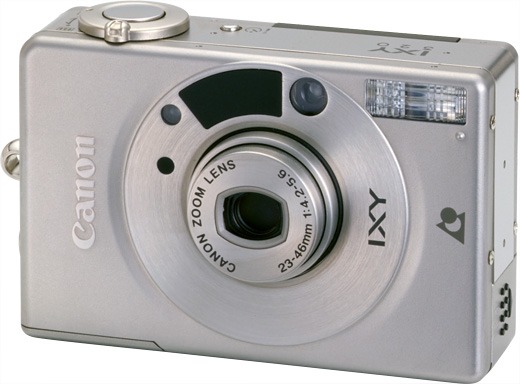 |
Canon had already hit on a winning formula with the APS film based Ixus cameras in the late 1990’s, their super compact design along with all metal construction made them an absolute dream for those travelling or who simply wanted to carry a camera with them at all times. Old magazines such as Amateur Photographer are full of letters from the time where people describe their love for these tiny cameras – the decent lens and fact that they really did slip into a pocket almost unnoticed made them hugely attractive to a range of buyers.
I’ve previously used an Ixus Z70 that came out at the end of the APS and film lifecycle, it offered a really quite refined experience with the only downside being that APS film is now so expired that the developed negatives are really washed out with odd colour casts. The Ixus film cameras had all sorts of nice design touches and innovations such as the rocker style zoom lever which surrounds the shutter button. Not having to look at a camera or move your hands to find controls is a sign of intelligent, well thought out ergonomic design choices. The only downside to the film Ixus bodies is that the viewfinder really is too small to be comfortable and pleasant to use. Personally, this is where I think the whole Ixus design philosophy was just so perfectly suited to digital.
Canon did indeed improve on the viewfinder for the digital Ixus series. Although you obviously don’t need one with a digital camera, it was included to help improve battery life and make those coming from APS Ixus’ feel right at home as soon as they picked it up. Back when these came out, I can remember making heavy use of the viewfinder with the screen off when on holiday just to make sure that the battery lasted the day – batteries were expensive then and a lowly student like me certainly couldn’t afford to walk around with a pocket full of spares.
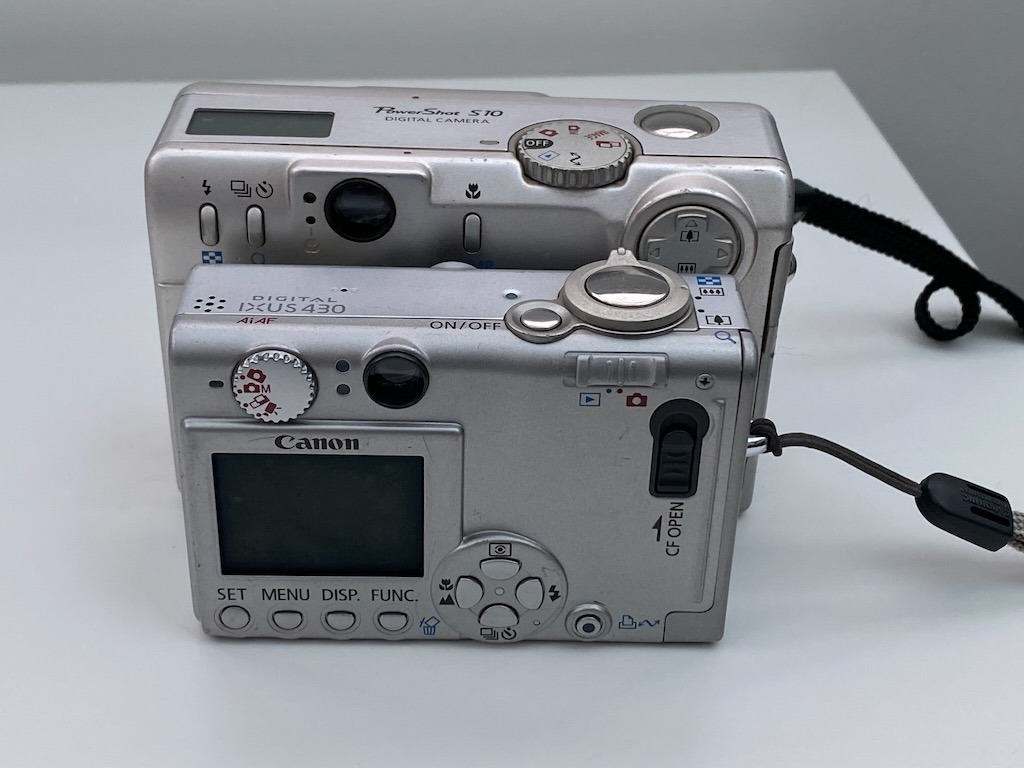
Talking of battery life, these make use of Lithium rechargeable batteries that not only last longer than the NI-MH type found in earlier Powershot cameras like the S10, they are significantly smaller too. Whilst I would not suggest that battery life in the Ixus 400 is impressive, anything is an improvement over the 15 minute S10 battery life.
The Powershot S10 was often referred to as the “digital Ixus” as it too carried forward a lot of the design language from previous film bodies. However, the Ixus 400 is a true refinement in every sense of the word. In the matter of just two years, Canon had managed to double the sensor resolution, improve the optical lens and zoom range, improve the video mode and refine the overall design – all in a package roughly 1/3 smaller than an S10 or 20. That tells you all you need to know about the sheer pace of development that took place in early 2000’s electronics across a range of fields.
In my opinion, the Ixus 400 and 500 represent the last of the truly perfect pocket digital cameras. They held on to the robust but functional rectangular build, before Canon decided to slim everything down further and push towards a “slippery bar of soap” design that never really struck me as being ergonomically decent. No doubt, later models were stuffed with high resolution sensors, outrageous optical zooms and huge screens, but from a usability perspective they lost so much. Canon went down the route of removing as many buttons as possible, moving options to on screen menus but honestly, I much prefer the sheer simplicity of earlier models that had far less screen clutter and physical buttons and dials.
Using the Ixus 400 today

If you want the short version of what the Ixus is like in day to day use, the answer is it’s great, I still love it. The long version is… it’s great, I still love it.
Power on isn’t the fastest, but once on everything is quick and responsive enough. Focus isn’t instant like you’d expect on a DSLR, every time the shutter is half pressed it makes this quiet purring noise and then gives you an indication on screen with a green box of what it has decided to focus on, before a tiny *click* noise of the shutter finally taking the image. Auto focus isn’t always perfect and there’s no way of selecting a focus point yourself but you can work around this in two ways. The first option is to select centre only focus which speeds things up, but you can also turn on a quick focus mode that is genuinely much faster but has the downside that it’ll occasionally fail to focus.
The screen is small but bright and clear enough to see most things well. You can’t really check focus but it’s good enough for everything else including image review and playback. Talking of image review, once you take a picture the review is almost instant which is a huge step up from the Powershot S10 and 20 which basically refuse to show you what you’ve just done.

The lens on the 400 and 500 can be described as “ok.” You get nice enough 4 or 5 megapixel jpg’s out of the camera which are perfectly sized for the kind of photography you’re using a compact pocket camera for. Shooting 15mp images on a compact doesn’t make too much sense to me when all they give you is a jpg out of the camera – if you’re going to shoot high resolution then surely you want the control that RAW gives you over your images. The Ixus 4 or 500 images are pretty much perfectly sized “snapshots” the kind of which you’d definitely have posted on social media (once it was invented, that is…)
Shooting images with sky or trees certainly shows the weaknesses in the lens. You get the telltale halos and fringes of chromatic aberrations around branches, especially in the corners. There’s some noticeable vignetting in some shots and the corners are obviously soft compared to the centre depending on the settings the camera decided to use when you pressed the shutter. None of these things are jarring enough for you to notice them all the time, they’re not visible in every frame you take and you can only really see them if you’re either looking for them zoomed right in, or you happen to produce very large prints.

High contrast scenes really confuse the camera, it’ll decide to either go all out for the sky or all out for the shadows and there’s certainly not enough dynamic range to get a decent compromise between the two – not without using manual settings. By dialling in some exposure compensation you can usually convince it to expose for the shadows at the expense of the sky, but being digital means you can of course bracket the exposures and just take away the one you like the most or even use that new fangled Photoshop thing that everyone is talking about and merge an HDR image. Whatever will they think of next? Computer generated, AI assisted object removal?!

Macro mode is fairly good fun. There’s enough resolution in the sensor to get some detail out of close up images if you can hold still enough in good light. The lens seems happiest at the wide angle when shooting macro but the depth of field is crazy if you get too close to the subject. In several of my macro shots I had one side of the image in focus whilst the other was blurred, mostly because I couldn’t hold the camera steady enough whilst it took the shot. Leaning the body up something or simply resting it on a wall or similar whilst using the self timer is definitely the way to go. In the shot above you can see exactly what I mean about edge softness with this lens, though.
There are a few built in picture modes to choose from such as vivid, black and white and the utterly awful sepia mode which makes everything look like an accident in a tanning salon. Images straight out of the camera have decent colour and saturation, I struggled to see a great deal of difference between standard mode and vivid, but then winter lends itself to dull, grey and washed out colours! There are a few more hidden settings that you might not notice unless you’d read the manual such as the very useful night mode which allows exposures of up to 30 seconds. Considering some modern phone cameras still don’t have this kind of feature, or give you control over it, that’s quite a nice touch.

Of course, there’s Stitch Assist mode which is my absolute favourite feature for no other reason that it almost compels you to take panoramic images more than you normally might. The image overlay that it gives you on screen almost guarantees decent panoramas as long as you remember to keep the camera relatively flat and your body pivoting around the same point. The software Canon provided to put your stitches together was never the best and you’d often get very hit or miss results with anything remotely complex. Fortunately, Photoshop seems to have no difficulty at all putting together even the busiest of scenes.
Conclusions and learning

Taking pictures at any time, anywhere, of anything we like is so ingrained in our day to day lives that no one would give it a second thought any more. The convenience and quality of mobile phone images is so good these days that most people barely need to consider anything else, but it hasn’t always been this way and still isn’t necessarily the best option.
Although phone cameras have been around a long time, they certainly came nowhere near the quality of compacts until around 2012. Iphone 4 and 5 images were very noisy close up and suffered a lot in low light. It’s only been a decade or so that we’ve been able to rely almost fully on the do it all device in our pockets rather than a dedicated compact.
That said, compact cameras still have physics on their side. Physically larger sensors and bigger lenses will always give better overall image quality and only when you compare pictures from “proper” cameras and phones side by side do you start to see the difference. A phone image and a DSLR image side by side are still startlingly different in their relative qualities.
I think in some ways it is a shame that convenience ultimately wins, it would genuinely be pointless for most people to carry a phone and a camera just for a subtle change in image quality. The Ixus line of cameras definitely filled a void from 2003/4 for a good decade and faithfully produced countless thousands of images that their owners will no doubt cherish to this day. I only stopped using my 500 in 2010 because it got dropped and
There’s something more about carrying a compact than just image quality, though. Carrying a compact almost reminds you to take pictures, more so than a phone would and they don’t suffer from the dreaded “camera roll of doom” where we take endless photos and as soon as they scroll off the top of our photo app, they’re mostly never looked at again. Compact cameras at least compel you to pull your images off the memory card, organise them and… whisper it, print them out!

There is no doubt that the Ixus 400 and 500 were superb cameras, perfectly designed for their intended market, function and purpose. Do they serve any particular purpose today? Well, no, not really but then the same is true of any number of compact digital cameras these days. They’re certainly ahead of the earlier 2-3 megapixel efforts that really don’t have any use other than scratching your nostalgia itch, and you cannot argue that the Ixus 4/500 gives perfectly decent pictures with enough detail to make prints from. In this sense, they’re still surprisingly serviceable machines – there really is no reason to think they’re obsolete. But… when you consider the convenience factor and that your mobile phone battery is so, so much better to the point where it makes the stamina of these cameras seem almost comedic, it isn’t difficult to see why so many languish in a drawer these days never to see the light again.
Unlike film SLR’s and other quirky cameras, digital compacts don’t have enough of that retro pull to make them compelling enough to deliberately dust off and go out to use. With an Ixus, you don’t have that need to slow down and consider each shot nor to manual focus like film. There’s no tactile advance lever between each shot and you don’t get the wow factor of looking at a DSLR raw image produced by a camera that cost you less than 2 pints of beer. Therein lies the problem, the Ixus is good, it’s a fine camera, but the irony is it’s so good that there’s no point using it any more because it does such a fantastic job of not getting in your way.
That and it’ll die on you.
Share this post:

